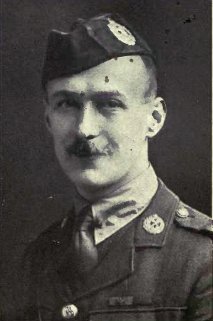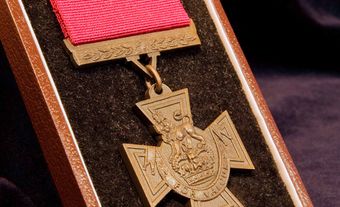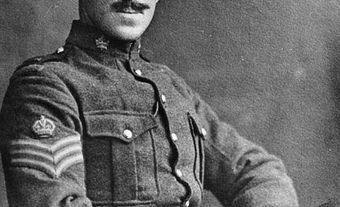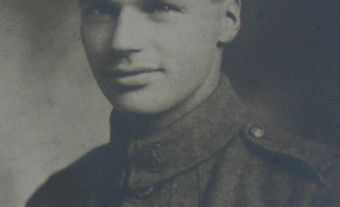Robert Shankland, soldier, accountant, Victoria Cross recipient (born 10 October 1887 in Ayr, Scotland; died 20 January 1968 in Vancouver, BC). During the First World War, Lieutenant Robert Shankland was one of three soldiers, all from the same street in Winnipeg, to be awarded the Victoria Cross (VC), the highest award for bravery among troops of the British Empire. The three VCs earned by the men of Pine Street — later named Valour Road — was a feat unmatched in any other part of the Empire.

Early Life
Born in Ayr, Scotland in 1887, Shankland emigrated to Canada with his friend George Ritchie in 1911. As a student, Shankland had been a top scholar and athlete, winning a medal for his achievements, and volunteering with the Scottish Presbyterian Boys’ Brigade, an organization dedicated to encouraging Christian manliness. He trained as an accountant in Ayr, and after arriving in Winnipeg worked as a cashier at a thriving local dairy, Crescent Creamery. Shankland boarded with the Ritchie family at 733 Pine Street, and was known for being a quiet and unassuming young man.
War Experience
When the First World War broke out, Shankland tried to join Winnipeg’s 79th Cameron Highlanders militia regiment, but finding no vacancies during the initial rush to enlist, he turned to a new unit, the 43rd Battalion (Cameron Highlanders of Canada). He excelled as a member of the 43rd and rose rapidly from private to orderly room sergeant. The 43rd Battalion left for Britain in June 1915, eventually forming part of the Third Division of the Canadian Expeditionary Force.
As he became known for his intelligence and leadership potential, Shankland was promoted to the rank of company sergeant major. His first experience with warfare came at the beginning of June 1916 at Mount Sorrel in Belgium, when the 43rd Battalion came under attack on the flank at Sanctuary Wood. Shankland displayed courage and initiative, volunteering during an intense counterattack on 4 June to lead a squad of stretcher-bearers to rescue wounded men as the battled raged on. Several of the injured men had been partially buried by artillery blasts. For his leadership and bravery under fire, Shankland was awarded the Distinguished Conduct Medal and later commissioned as a lieutenant.
Bravery at Passchendaele
In October 1917, at the Battle of Passchendaele, the 30-year-old Shankland again showed his tenacious fighting spirit. On 26 October, the 43rd Battalion was assigned the objective of capturing Bellevue Spur, an adjoining hill with a trench system considered a main line of defence at Passchendaele Ridge.
In the early dawn the battalion marched into the conditions for which this battle was so well known: mud, cold, heavy shelling and a horrendous casualty rate. Facing determined German resistance, Shankland’s battalion had to overcome 14 concrete gun emplacements to capture the Spur. Under orders to attack relentlessly even against intense machine gun fire, the troops of the battalion persisted. At first, they made good progress with their advance but were soon caught in a German crossfire. Dozens were killed or wounded, yet the platoon under Shankland managed to hold a portion of Bellevue Spur and withstand several deadly counterattacks.

After organizing the survivors of his platoon for what seemed a desperate last stand, Shankland kept the Germans back with just a single machine gun. He then went to the rear to round up reinforcements from the 52nd Battalion. His report to battalion headquarters identified a weakness in the German artillery coverage, and pointed to a possible route along which an impromptu group could advance. A hasty new attack was ordered. As the group moved forward, attacking pillboxes from the flank and firing rifle grenades, Lewis guns and hand grenades, the attackers were able to effectively put an end to the German resistance at Bellevue Spur.

From 26 to 29 October, Canadians suffered almost 2,500 casualties at Passchendaele, but held ground against an enemy that had earlier stopped Australian and New Zealand forces. The battle at Bellevue Spur helped place Canadians on higher, drier ground, and provided a good position from which to launch the final offensives at Passchendaele.

Victoria Cross
For his inspired leadership at Bellevue Spur, Shankland was nominated for the Victoria Cross, for converting what appeared at first to be a disastrous defeat into a legendary success. A few weeks after the battle, he was awarded the VC in person by King George V. The award citation commended Shankland “for most conspicuous bravery and resource in action under critical and adverse conditions. …his courage and splendid example inspired all ranks and coupled with his great gallantry and skill undoubtedly saved a very critical situation.”
Shankland was the last of three men from Pine Street — along with Sergeant-Major Fred Hall and Corporal Leo Clarke — to receive the Victoria Cross. Today their VCs are held by the Canadian War Museum. Shankland was the only one of the three to survive the war. In 1925, he attended the ceremony for the renaming of Winnipeg's Pine Street as “Valour Road” in honour of himself, Hall and Clarke. Their heroism was featured in “Valour Road,” a Heritage Minute released in 1991. Canada Post issued a stamp honouring the three men in October 2021.
Shankland would go on to serve as camp commander for the Canadian headquarters in England during the Second World War.

(See also The Canadian Great War Soldier and Evolution of Canada's Shock Troops.)

 Share on Facebook
Share on Facebook Share on X
Share on X Share by Email
Share by Email Share on Google Classroom
Share on Google Classroom


